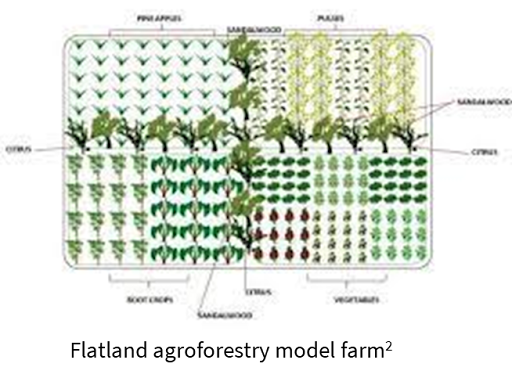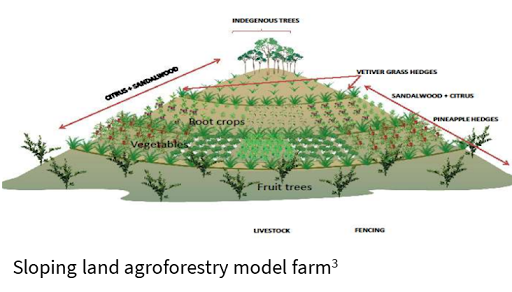Agroforestry is a land use management system that combines trees or shrubs with agricultural land use such as crops or![]() pastures. The approach combines agriculture and forestry to create integrated and sustainable land-use systems. By diversifying land use, an agroecological succession is initiated that enhances the functionality and sustainability of the agricultural system whilst also providing access to marketable products from the trees and shrubs (e.g. fruits, nuts, medicines). The use of agroforestry has multiple benefits including enhanced crop yields, improved income generation, increased biodiversity, improved soil structure, reduced erosion and sequestration of carbon. Agroforestry complements and reinforces traditional reforestation efforts by reducing the pressure on remaining natural forests and providing environmental services.
pastures. The approach combines agriculture and forestry to create integrated and sustainable land-use systems. By diversifying land use, an agroecological succession is initiated that enhances the functionality and sustainability of the agricultural system whilst also providing access to marketable products from the trees and shrubs (e.g. fruits, nuts, medicines). The use of agroforestry has multiple benefits including enhanced crop yields, improved income generation, increased biodiversity, improved soil structure, reduced erosion and sequestration of carbon. Agroforestry complements and reinforces traditional reforestation efforts by reducing the pressure on remaining natural forests and providing environmental services.
Potential agroforestry interventions include:
- Alley or intercropping: Planting of tree rows to create alleys within which agricultural crops can be produced. Careful planning can create improvements in farm microclimates like temperature and water retention, ultimately mitigating the impacts of climate change.
- Riparian forest buffers: Areas adjacent to waterways or wetlands that are managed differently with the aim of reducing erosion of productive agricultural land. Riparian buffers can stabilise eroding banks, prevent erosion, filter sediment from runoff and reduce flood damage down stream
- Silvopasture: Integrating productive trees and grazing livestock providing both short and long term income sources
- Windbreaks: Linear plantings of trees and shrubs designed to provide protection to other agriculture pursuits while at the same time presenting an income stream for the farmer. Windbreaks protect other crops from physical damage from extreme events and improve water retention and soil health.
Examples of agroforestry approaches used in the Pacific for different farm types include:
- Flatland Farm: In flatland areas, a farm can be divided into rectangular plots and different species are planted in
 each of the plots (e.g. pineapples, yams), whilst the perimeter is lined with trees (e.g. sandalwood and citrus trees).
each of the plots (e.g. pineapples, yams), whilst the perimeter is lined with trees (e.g. sandalwood and citrus trees).
- Sloping land farm: In sloping areas, a farm can be divided according to the elevation. Indigenous trees and vetiver
 grass hedges at the top can merge into root crops and vegetables in the middle and fruit trees at the bottom where livestock can also feed. The periphery is then lined with sandalwood and citrus plants.
grass hedges at the top can merge into root crops and vegetables in the middle and fruit trees at the bottom where livestock can also feed. The periphery is then lined with sandalwood and citrus plants.
Agroforestry implementation would be of medium cost as it does not require significant capital works but does require both human resources (e.g. for planting, maintenance) as well as initial outlay on materials (e.g. plants, fencing). Whilst providing cost estimates is difficult given the broad range of influencing factors across the Pacific, the below table outlines the key components that should be taken into account when estimating an agroforestry project budget for a specific location.
|
|
|
|
|
|
|
|
||||
|
|
|
|||
|
|
|
|||
|
|
|
|||
|
|
|
|||
|
|
|
|||
|
|
||||
|
|
|
|||
|
|
|
Agroforestry is compared against monoculture using mechanical farm operations. Monoculture techniques use standard farm operations by planting one crop which is then harvested at the same time using farm equipment.
Comparison of the two approaches is presented below:
|
|
|
|
|
|
|
|
|
|
|
|
- -
Agroforestry Guides for Pacific Islands. See https://agroforestry.org/books/agroforestry-guides-for-pacific-island
- -
Research on Ecosystem Research on Ecosystem-based Adaptation (EbA): A reference guide. See https://reliefweb.int/sites/reliefweb.int/files/resources/Research%20on%20EbA_a%20reference%20guide_by%20EbA%20South.pdf
- -
Promoting Agroforestry to Develop Resilience to Climate Change and Food Security of Communities in Pacific Island Countries, Secretariat of the Pacific Community. See http://www.asiapacificadapt.net/adaptationforum/sites/default/files/4.%20APAN%20Presentation%20-%20Cenon%20Padolina%2025Sept2014.pdf
- -
Human health and Climate change in Pacific Island countries, Western Pacific Region. See https://www.who.int/publications/i/item/human-health-and-climate-change-in-pacific-island-countries
- -
Agroforestry for Adaptation and Mitigation to Climate Change. See https://siwi.org/wp-content/uploads/2020/02/Agroforestry-for-adapation-and-mitigation-to-climate-change_web.pdf
- -
1. A Planetary Health Perspective on Agroforestry in Sub-Saharan Africa. See https://www.sciencedirect.com/science/article/pii/S2590332219301319
- -
2,3. Promoting Agroforestry to Develop Resilience to Climate Change and Food Security of Communities in Pacific Island Countries, Secretariat of the Pacific Community. See http://www.asiapacificadapt.net/adaptationforum/sites/default/files/4.%20APAN%20Presentation%20-%20Cenon%20Padolina%2025Sept2014.pdf
Case study
Nadroumai Women improve soil health through Agroforestry
The Secretariat for the Pacific Community’s (SPC’s) Sustainable Forestry and Landscape Management Program (SFLMP) implemented a four-year project titled ‘Enhancing value-added products and environmental benefits from agroforestry systems in the Pacific’. The project promoted agroforestry and sustainable agriculture in the Nadroumai catchment, Fiji, where resource exploitation and unsustainable agriculture had resulted in exacerbated erosion, flooding and drought events.
The project began with community awareness activities and learning about community decision-making processes. Local partners were identified and agreed to set up and manage a tree nursery. SPC helped establish the nursery and organised training in nursery management, tree propagation and essential business skills with a focus on training of women. SPC also facilitated the development of business by-laws with a clearly laid out benefit-sharing mechanism that allowed the women to benefit from their activities.
By the end of the project a total of 10 hectares were planted under agroforestry, leading to improved agricultural outcomes. In addition, the income received from the tree nursery is being used to fund development projects. As a result of the project, the community was able to achieve Sustainable Development Goal 15 in addition to enabling local women to create income opportunities for their community.
Reference: Secretariat of Pacific (SPC), https://www.spc.int/updates/blog/2020/03/nadroumai-women-improve-soil-health-through-agroforestry
